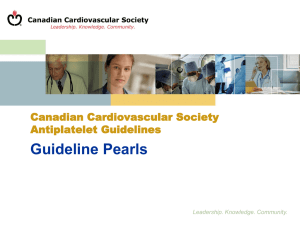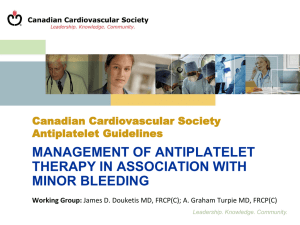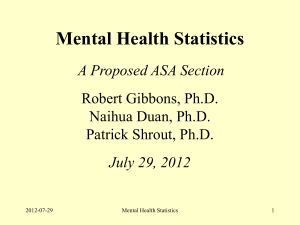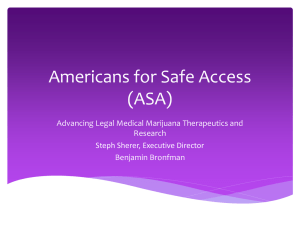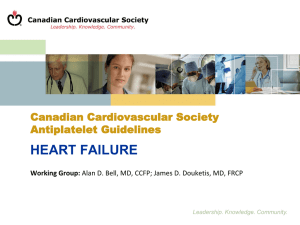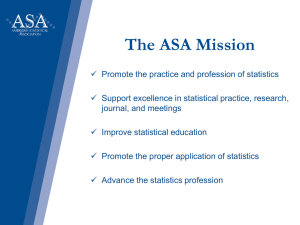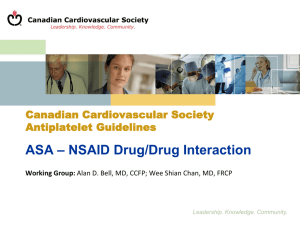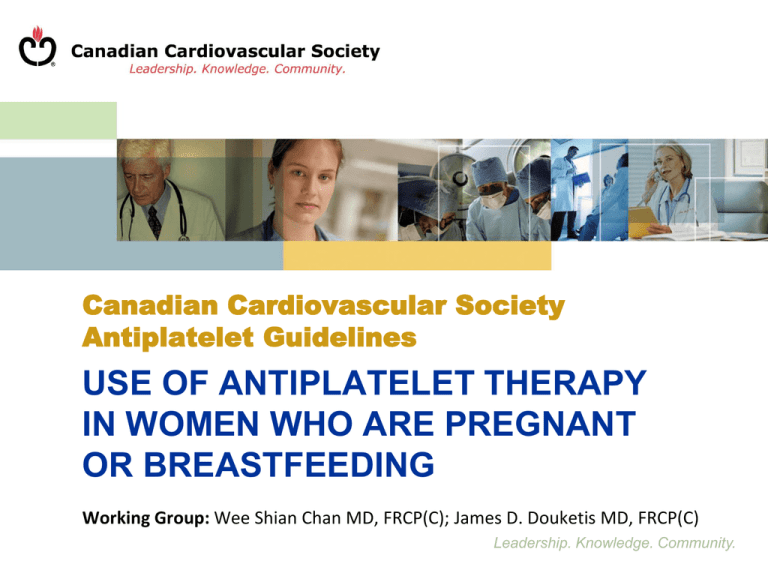
Canadian Cardiovascular Society
Antiplatelet Guidelines
USE OF ANTIPLATELET THERAPY
IN WOMEN WHO ARE PREGNANT
OR BREASTFEEDING
Working Group: Wee Shian Chan MD, FRCP(C); James D. Douketis MD, FRCP(C)
Leadership. Knowledge. Community.
Objectives
Evaluate the Canadian Cardiovascular Society Guideline
recommendations regarding the use antiplatelet therapy
in pregnant and lactating patients.
Evaluate the risks and benefits of antiplatelet therapy
in pregnant and lactating patients.
© 2011 - TIGC
Case study
36 year old woman with a history of pre-eclampsia
during her last pregnancy, 2 years ago, that resulted
in a miscarriage is now 9 weeks pregnant.
Other medical problems:
Central obesity (BMI = 38 kg/m2)
Mild hypertension (systolic BP = 135-145 mmHg)
Type-2 diabetes (diet + oral hypoglycemic drugs)
She has been reading about the risks of ASA during
pregnancy and is concerned about the potential for
congenital malformations.
© 2011 - TIGC
Management question
A. Start ASA, 325 mg daily, but wait until 2nd trimester.
B. Start ASA, 325 mg daily, now.
C. Start ASA, 81 mg daily, but wait until 2nd trimester.
D. Start ASA, 81 mg daily, now.
E.
Monitor BP carefully but no ASA needed.
© 2011 - TIGC
Evidence: ASA and pre-eclampsia
Associated with modest (15-20%) reductions in relative risk
for pre-eclampsia:
OR = 0.86 (95% CI: 0.76-0.96)
RR = 0.81 (95% CI: 0.75-0.81)
© 2011 - TIGC
Evidence: ASA and congenital malformations
Meta-analysis investigating 1st trimester ASA use
No increased risk for congenital malformations:
OR = 1.33 (95% CI: 0.94-1.89) increased risk for
gastroschisis (herniation of abdominal contents
through abdominal wall defect):
OR = 2.37 (95% CI: 1.44-3.88)
Absolute risk increase
0.8-5.8/10,000 births to 23/10,000 births
Limitations of meta-analysis
Possibility of recall bias
Uncertainty about ASA dose in affected pregnancies
© 2011 - TIGC
7
®
Recommendation
Low-dose ASA (75-162 mg daily) is likely safe for use
during the first trimester of pregnancy (Class IIa, Level A).
Low-dose ASA can be used safely during the second
and third trimesters of pregnancy (Class I, Level A).
What if?
She receives ASA 81 mg daily for the duration of an
uneventful pregnancy. She remains at increased risk
for pre-eclampsia-related complications in the postpartum period.
She asks whether it is safe to continue ASA during
breastfeeding?
© 2011 - TIGC
Management question: During breastfeeding
A. Do not continue ASA post-partum.
B. Continue ASA post-partum for 1 week.
C. Continue ASA post-partum for 4 weeks.
© 2011 - TIGC
Evidence: ASA and breastfeeding
Maternal ingestion of ASA associated with excretion
of salicylate and salicylate metabolites into breast milk.
Few case reports of adverse side effects (e.g., metabolic
acidosis, thrombocytopenia) in infants with use of highdose ASA (several grams/day).
Theoretic risk for Reye's syndrome in infants due to
salicylate in breast milk unknown.
Use of low-dose ASA (75-162 mg daily) during
breastfeeding has not been reported to result in
adverse infant outcomes and is mostly considered safe.
© 2011 - TIGC
11
®
Recommendation
Low-dose ASA (75-162 mg daily) may be considered for use
in breastfeeding women (Class I, Level C).
Use of agents other than low-dose ASA by breastfeeding
mothers should only be considered after weighing maternal
benefits with potential risks for the newborn (Class IIb, Level C).
12
®
Antiplatelet therapy in patients pregnant or lactating
© 2011 - TIGC

